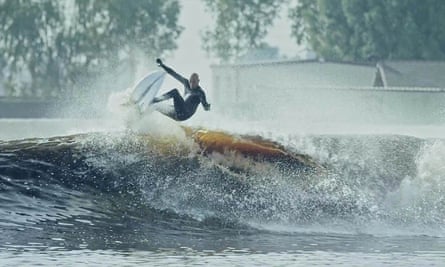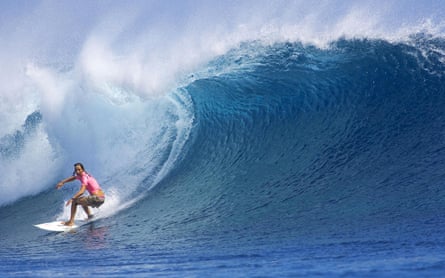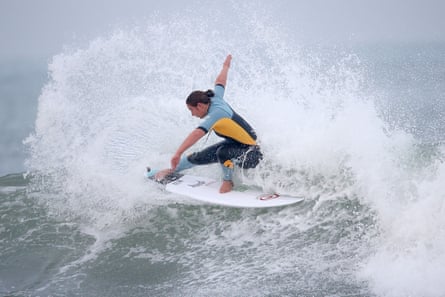Sun-bleached eyebrows were raised skyward when surfing’s professional body, the World Surf League, announced recently that a man-made wave on an inland lake in California would become stop number eight of the 2018 World Championship Tour.
Next year, the world’s top surfers will abandon the coast for the dusty town of Lemoore, almost 200 miles (300km) from the ocean, where the brainchild of 11-time world champion Kelly Slater lies at a place called Surf Ranch.
“This is the first repeatable man-made wave that convincingly delivers the power and shape of ocean waves,” said the World Surf League (WSL) when it bought the Kelly Slater Wave Company (KSWC) last year. It was the product of more than 10 years of secretive research by fluid mechanics specialist Adam Fincham, and Slater.
The pair had revealed their invention only a year earlier, with video showing Slater riding a smooth, brown wave, about head-high and exceptionally fast. At one point the wave folded over him and he rode inside the tube for several seconds before launching a 360-degree aerial spin and landing with his arms raised.
It was a historic moment, taking surfing into fresh, uncharted waters as part of a much-anticipated shake-up of the world tour schedule. Suddenly a fake wave looked as good as a real one. And by buying the majority share in Kelly Slater’s perfect wave machine, the WSL signalled its clear intent that wave pool events would be part of the pro tour’s future.

Surf Ranch is a man-made lake 700 metres long and 150 metres wide in central California. A heavy metal train runs its length along what looks like a seaside pier, pushing water forward with a specially designed hydrofoil blade. When a surfer next to the pier catches the forward-moving water and rides it, they are surfing, as if they were on a real ocean swell.
The mechanics of surfing
But many surfers are uneasy about wave pools going mainstream and the idea of a new generation of surfers with no understanding of the sea.
“Surfing is about the randomness of the ocean: chance, luck, wave knowledge, ocean knowledge,” says Ben Marcus, former editor of Surfer magazine and author of Surfing USA! and The Surfing Handbook among others. “It’s not all just mechanics.”
This is the classic objection to wave pools, shared by almost everyone who has paid in frustration and the beatings that Mother Nature demands along surfing’s learning curve. Until now, all surfers have had to do battle with natural forces to find the thrill of the ride. In this sense, the argument goes, wave pools seem shallow and soulless.
It perhaps doesn’t help that the wave pool event and a return of a venue in Bali on the world tour schedule forced out two popular events: Trestles in California, and Cloudbreak in Fiji.
The Fiji event – suspended due to a lack of political support, according to WSL – happens on an open-ocean reef and contestants take boats to the site from two tiny island resorts several miles away. It is a spectacular location for the best surfers in the world to show their talent in swells of consequence – swells that have travelled thousands of miles from storms in the Southern Ocean before breaking with frightening power on the shallow Cloudbreak reef.

Adding the artificial wave to the tour so soon is a bold move by the new British CEO of the WSL, Sophie Goldschmidt. Fresh in the job but highly experienced in mainstream sports promotion, her role is to take surfing to the masses and artificial waves might be the key. “This technology, and its ability to deliver high-quality waves at any location in the world opens so many possibilities for how we can complement and evolve the competitive experience,” says Goldschmidt. She stresses that the 2018 event will itself be a test, but leaves no doubt that WSL is committed to building a network of similar facilities across the world.
“We’ve already targeted six developments that have begun, or will shortly be underway,” she told journalists recently.
The WSL is not alone in its push to take surfing inland. Artificial wave parks using the Basque-made Wave Garden technology, different to the KSWC hyrdofoil, are already open in San Sebastian, Austin, Texas and Surf Snowdonia in Wales. Next week ground will be broken on The Wave in Bristol, in the UK, soon to be followed by The Wave in London. Perth, Melbourne, Barcelona, Dusseldorf – almost every week, planning permission is granted for a wave pool somewhere in the world.

“More pools means more inclusion,” says Matt Knight of the governing body Surfing England. “One of the big opportunities is the possibility that we could introduce the joy of wave riding to a more diverse group,“ he says.
“Yes, new technology starts expensive. But if this goes mainstream then the price drops, maybe in 20 years a schoolchild from a landlocked inner-city estate – who might actually be as naturally talented as Stephanie Gilmore or Kelly Slater – will have their life changed because surfing is on the curriculum and their teacher could book the local wave pool once a week.”
Another common concern the WSL will have to address is will its events become boring? “A contest at the wave machine – if it’s the same wave every time – will be like floor exercises in Olympic gymnastics: interesting, but repetitious and missing the point in some ways,” says Marcus.
‘A poor second to trekking over the sand dunes’
But wave-makers dismiss the issue. Randomness, they say, can be increasingly effectively programmed into these highly computerised wave systems, as can swell height and the shape of the underwater floor which affects where and how powerfully the wave breaks.

But equally it is this degree of control that makes many surfers uneasy. “Wave pools will always be a poor second to trekking over the sand dunes, finding that empty bank at the right tide, with just the right winds,” says Andy Cummins of campaign group Surfers Against Sewage. “Those are the sessions we live for.”
There are environmental concerns, too. Both Surf Ranch and The Wave are 100% powered by renewable energy, but Matt McClain, a former CEO of Surfrider Foundation USA, is worried the arrival of perfect artificial waves might put ocean surf spots in danger. His best example is Trestles in California, one of the contests sidelined by the WSL for 2018.
“By opting to drop Trestles in favour of an artificial wave, the WSL has devalued the surfing resources [there] which, given the ongoing 20-year battle to protect the break from a proposed toll road project, has larger implications,” he says.
McClain fears artificial waves will be used by coastal developers as leverage to mitigate damage to natural shorelines. “What if a developer decides to extend the breakwater at Oceanside, damaging the surf break. In exchange, they then offer to build a wave park somewhere off Route 76. Is that OK?”
Despite the concerns and objections, artificial waves have arrived. We know this because serious surfers have have long treated them with disdain. “Wave pools have been around for a long time, but they’ve been shitty,” Randy Rarick, veteran contest organiser and a founding father of professional surfing told Surfline.com after trying the wave at Lemoore’s Future Classic event in September. “I didn’t see a single person walk out of there shaking their head. Nobody went: ‘Nah this is bogus; this will never replace an ocean wave.’ I didn’t hear a single negative thing from anyone.”
So with the best surfers in the world “frothing” over fakery – the WSL insists the athletes had a big voice in the decision to add Surf Ranch to the tour – the first phase of mainstreaming has begun. How far surfing will penetrate inland is the great unknown, but for now, momentum is with the WSL’s high-profile strategy.
“The first event will definitely attract a lot of eyeballs, because the wave is just so mesmerising,” says Marcus. “It will be up to the surfers to make it interesting and hold the fascination of people who surf, and people who don’t.”
- This article was corrected on 2 December 2017. Matt Knight is part of Surfing England, not Surfing GB.

Comments (…)
Sign in or create your Guardian account to join the discussion